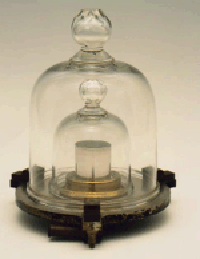Prototype of kilogram weighs less kg!

A kilogram just isn't what it used to be.
A 118-year-old cylinder that has been the international prototype for the metric mass, and kept tightly under lock and key outside Paris, is mysteriously losing its weight - if ever so slightly.
Physicist Richard Davis of the International Bureau of Weights and Measures in Sevres, southwest of Paris, says the reference kilo appears to have lost 50 micrograms compared with the average of dozens of copies.
"The mystery is that they were all made of the same material, and many were made at the same time and kept under the same conditions, and yet the masses among them are slowly drifting apart," he said.
"We don't really have a good hypothesis for it," Davis said in a phone interview Wednesday.
But only the one in Sevres really counts. It is kept in a triple-locked safe at a chateau and only rarely sees the light of day - mostly for comparison with other cylinders shipped in periodically from around the world.
"It's not clear whether the original has become lighter, or the national prototypes have become heavier," said Michael Borys, a senior researcher with Germany's national measures institute in Braunschweig. "But by definition, only the original represents exactly a kilogram."
The kilogram's inconstancy illustrates how technological progress is leaving science's most basic measurements in its dust. The cylinder was high-tech for its day in 1889 when cast from a platinum and iridium alloy, measuring 3.9 centimeters, or 1.54 inches, in diameter and height.
At a November meeting of scientists in Paris, an advisory panel on measurements will present possible steps toward basing the kilogram and other measures - like Kelvin for temperature, and the mole for amount - on more precise calculations. Ultimately, policymakers from around the world would have to agree to any change.
Even countries that don't use the metric system could be affected by the kilogram's uncertainty: the kilogram is also the ultimate weight standard for the U.S. customary system, where it equals 2.2 pounds.
But don't expect the questions about the kilo to lead to public campaigns to lower the price of bread, or cause wary waistline-watchers to re-examine their weights: 50 micrograms is roughly equivalent to the weight of a fingerprint.
"For the lay person, it won't mean anything," said Davis. "The kilogram will stay the kilogram, and the weights you have in a weight set will all still be correct."
But for scientists who rely on the official kilogram for minute measurements every day, the inconstant metric constant is a nuisance - threatening calculation of things like electricity generation.
"They depend on a mass measurement and it's inconvenient for them to have a definition of the kilogram which is based on some artifact," said Davis, who is American.
Many measurements have undergone makeovers over the years.
The meter was once defined as roughly the distance between scratches on a bar, a far cry from today's high-tech standard involving the distance that light travels in a vacuum.
One of the leading alternatives considered for a 21st-century kilogram is a sphere made out of a Silicon-28 isotope crystal, which would involve a single type of atom and have a fixed mass.
"We could obviously use a better definition," Davis said.
Subscribe to Pravda.Ru Telegram channel, Facebook, RSS!


